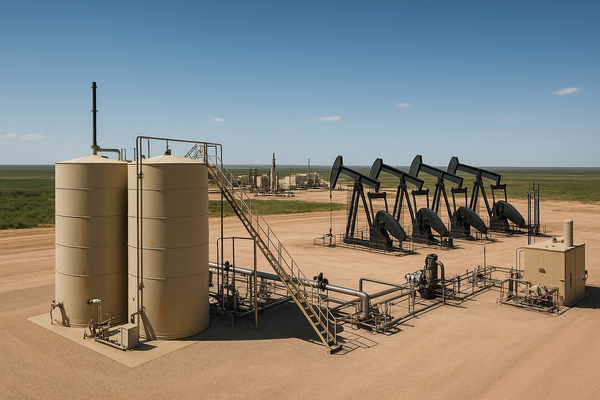
Occidental Petroleum (NYSE:OXY) reported stronger-than-expected third-quarter production and completed a $9.7 billion sale of OxyChem, boosting free cash flow and enabling sustained shareholder payouts. The news matters now because it combines near-term cash-generation relief with a strategic cleanup of legacy chemical assets, reshaping capital flexibility for US oil producers. In the short term, investors rewarded production beats and the OxyChem proceeds; over the long term, the move reduces leverage and supports ongoing dividends and buybacks. The result reverberates across US upstream names, Canadian peers, and midstream firms that service higher volumes, while global oil and chemical markets reassess capacity and funding trends relative to recent quarters.
What’s Driving the Market?
Strong Q3 operational prints and corporate portfolio moves are driving investor focus. Occidental delivered a beat on production while selling OxyChem for $9.7 billion; the company also reported quarterly earnings that market summaries flagged as resilient. Meanwhile, natural gas forecasts turned colder, lifting short-term nat-gas prices and giving a boost to Appalachian producers. These dual drivers are pushing capital back into energy equities this week as traders price in improved cash flow and seasonal demand.
The timing matters. OxyChem proceeds arrived before year-end, lowering leverage ahead of potential 2026 capital plans. Colder weather forecasts increase near-term gas demand across the US, Europe, and Asia, tightening winter supply expectations and raising the earnings prospects for gas-weighted names.
Upstream producers: production beats, asset sales and the capital puzzle
Occidental Petroleum (NYSE:OXY) led headlines with a production beat and a major asset sale. The company posted Q3 profit of roughly $830 million, or about $0.65 per share, alongside a strategic $9.7 billion divestment that management said reduces net debt and funds shareholder returns. That combination drove analyst attention on valuation and balance-sheet repair rather than short-term commodity moves.
APA Corporation (NASDAQ:APA) also grabbed attention after Q3 results beat estimates, powered by solid production and cost control despite weaker oil prices. Yet Bank of America retained a bearish stance on APA, citing high operating costs in the Permian Basin and maintaining a $20 price target. That contrast—earnings beats but lingering cost concerns—illustrates why investors are parsing quality of production and margin durability, not just headline volumes.
Context: producers that can convert higher sales volumes into durable free cash flow are trading at a premium versus peers still working down leverage. Occidental’s transaction is an example of the deleveraging path investors reward; APA’s cost profile shows why markets remain selective.
Gas and midstream: seasonal demand and infrastructure beneficiaries
Antero Resources (NYSE:AR) showed a meaningful rebound in Q3 with revenue of about $1.214 billion and a return to net income of roughly $76.2 million. The company also closed multiple West Virginia acquisitions, increasing production capacity and midstream optionality. Antero’s results and acquisitions pushed its shares up; the stock gained roughly 3% on the day with a roughly 6% rise over the past month, reflecting renewed investor confidence in gas exposure ahead of winter.
Midstream names rallied as winter forecasts turned colder. Targa Resources (NYSE:TRGP) jumped 11.7% over the week after a stronger-than-expected Q3 report, highlighting the pricing and volume sensitivity of midstream cash flows. EQT Corporation (NYSE:EQT) climbed roughly 8% following the nat-gas price uptick, underscoring how short-term weather can amplify volumes and margin metrics for gas producers and pipelines.
Macro link: a colder-than-expected winter tightens regional gas balances in the US and Europe. That raises utilization and cash generation for midstream infrastructure, which in turn supports distributions and lowers implied risk for those securities in the near term.
Nuclear, coal and diversified energy: policy tailwinds and commodity rallies
Cameco (NYSE:CCJ) picked up momentum after renewed political support for nuclear. Analysts at UBS initiated coverage with a neutral rating but the sector benefited from policy focus on reliable baseload power. Cameco headlines also followed public commentary from US policymakers pushing nuclear expansion, which has global implications for utilities and uranium markets in Canada and Europe.
Coal names and diversified players posted notable moves. Peabody Energy (NYSE:BTU) rose over 10% one week after posting gains in the coal complex; the move reflects tightening thermal coal fundamentals in parts of Asia and persistent demand for metallurgical coal in steelmaking. TotalEnergies (NYSE:TTE) remains highlighted as a long-term European oil and LNG exposure with an active shareholder-return profile, which investors weigh versus pure-play upstream names.
These moves show investors are balancing near-term commodity rallies with policy-driven structural bets on energy security and fuel mix diversification globally.
Investor Reaction
Trading flows show selective rotation: buyers favored names with immediate cash-flow improvement and visible deleveraging. Occidental’s combination of a production beat and a large asset sale produced outsized attention from income-focused investors seeking dividend sustainability. Volume surges were visible in several names that reported beats or announced transformative transactions, including Antero and Targa.
Analysts reacted with mixed guidance updates. Bank of America’s maintained sell on APA underscores the caution around basin-level cost structures. UBS’s initiation on Cameco signals measured interest in policy beneficiaries rather than broad-sector conviction. ETF flows into energy and commodity-linked funds ticked higher on the weekly data, reflecting institution-level reallocation toward higher-yielding energy cash flows.
What to Watch Next
Near term, monitor winter weather models and front-month natural gas curves; sustained cold risks further upside in gas-exposed names and midstream volumes. For corporates, watch final close metrics from OxyChem integration proceeds and any updated guidance from Occidental on debt paydown and buybacks.
Look for analyst revisions and rating actions on APA and other Permian-heavy producers as cost data and Q4 guidance arrive. Monitor M&A chatter: Antero’s West Virginia deals show upstream consolidation remains active where gas basins offer scale advantages. Finally, regulatory and policy announcements on nuclear support will matter for uranium and utility-linked equities globally.
Potential catalysts next week include Q4 production guidance updates, midstream tariff disclosures, and any incremental capital-allocation commentary from major US producers. These items will determine whether current flows persist or rotate into defensive energy names.












